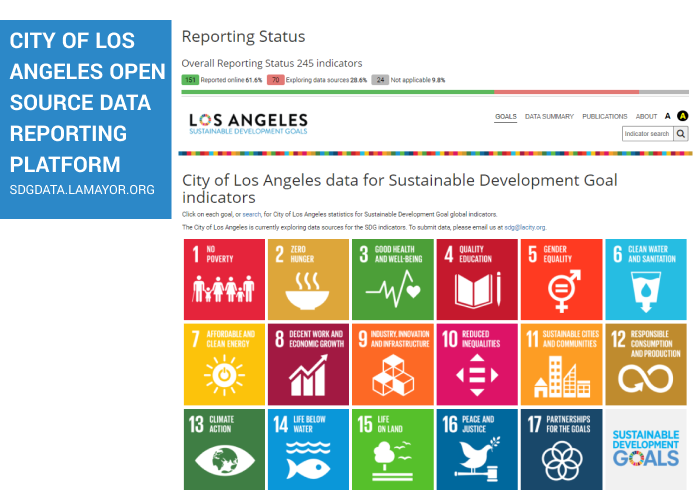Los Angeles, United States of America
Open Source Tools for Action on the SDGs

Basic City Data Population size: 3979576 Population Growth Rate(%): 0.32 Surface Area (sq.km): 1300 Population Density (people/sq.km): 3061 GDP Per Capita (U.S.$): 70802 GINI Index: 0.5 Main Source of Prosperity (e.g. industry, trade, tourism, creative industry, etc.): Finance, Professional and Business Services, Creative Industry, and Manufacturing
Seeking to improve the lives of L.A. residents via the Sustainable Development Goals (SDGs), and in order to develop and share SDG tools in a transparent way, Los Angeles is pioneering two open-source mechanisms for SDG action at the sub-national level: the SDG Data Reporting Platform (Open SDG) and the SDG Activities Index. While Open SDG was developed for national statistics, L.A. is the first city to adapt it for sub-national reporting. The SDG Activities Index is a living, crowd-sourced encyclopaedia of organizations advancing the SDGs in L.A. It is searchable, exportable, and allows residents to build shared capacity and learn about the SDGs. Both of these tools have wikis, and their code can be reused by other cities and organizations. The platform was chosen and implemented by the City of L.A.’s Information Technology Agency (ITA) in partnership with the Mayor’s Office of International Affairs (MOIA) and the Mayor’s Fund for Los Angeles (MFLA).
The TC recommends this initiative for several reasons:
1. Leadership - L.A. is the only global city currently reporting directly on the SDG indicators;
2. Transparency and Replicability - The tools are easily replicated by any sub-national government or organization who wishes to do the same;
3. Innovation - L.A. is the only city in the world aggregating projects and organizations across the public, private, and non-profit sector and linking them to the SDGs, actively building capacity to achieve the Goals within the community;
4. Foresight - L.A. is actively using the SDG monitoring and mobilization data to identify gaps to 2030, developing new analysis and visualization tools that will help them and other cities.
Although data are collected and tracked against all 17 SDGs, this initiative is most highly relevant to Goal 11: Make cities and human settlements inclusive, safe, resilient and sustainable. It also monitors a complete set of indicators relevant across the New Urban Agenda.


 In Focus | International Day of Families: Family-Oriented Policies for Sustainable Development
In Focus | International Day of Families: Family-Oriented Policies for Sustainable Development City Stories | How human-centred cities address multidimensional poverty and build urban resilience in Latin America
City Stories | How human-centred cities address multidimensional poverty and build urban resilience in Latin America In Focus | Earth Day: Our Power, Our Planet
In Focus | Earth Day: Our Power, Our Planet




















 Tel: +86 20 3780 4434
Tel: +86 20 3780 4434 Email: info@guangzhouaward.org
Email: info@guangzhouaward.org Address: Rm 1609, FuLiXinTianDi, No.307 Guangzhou Dadao Zhong, Yuexiu District, Guangzhou, Guangdong, 501600, PRC
Address: Rm 1609, FuLiXinTianDi, No.307 Guangzhou Dadao Zhong, Yuexiu District, Guangzhou, Guangdong, 501600, PRC




